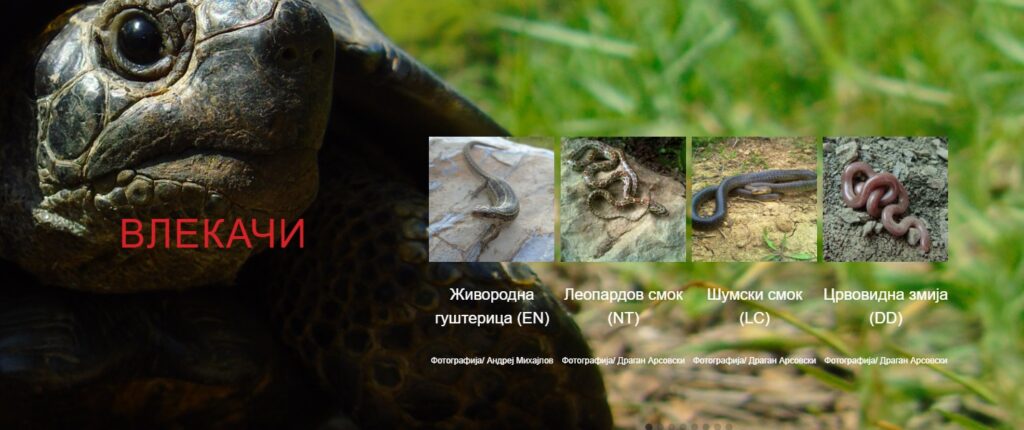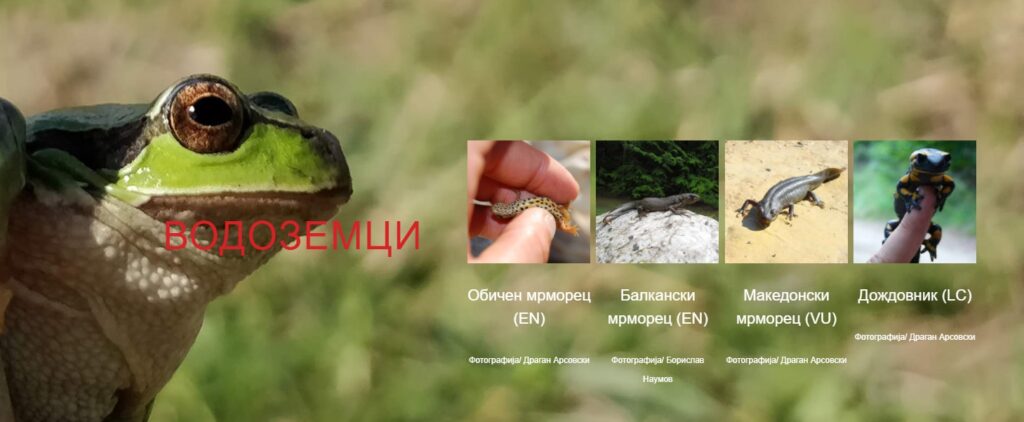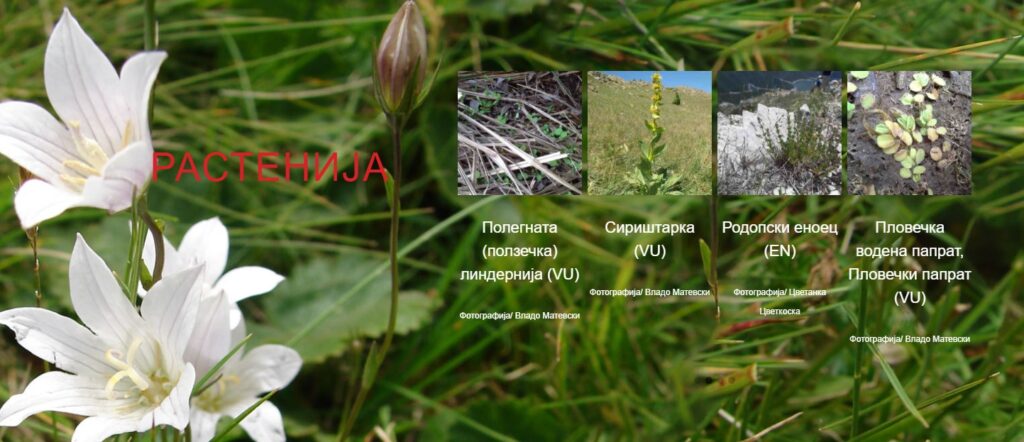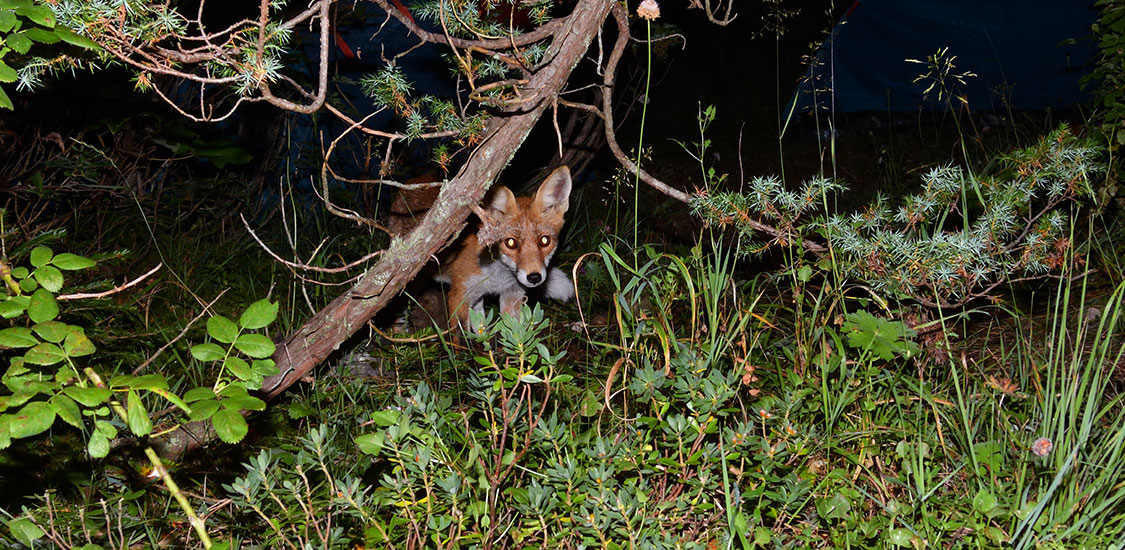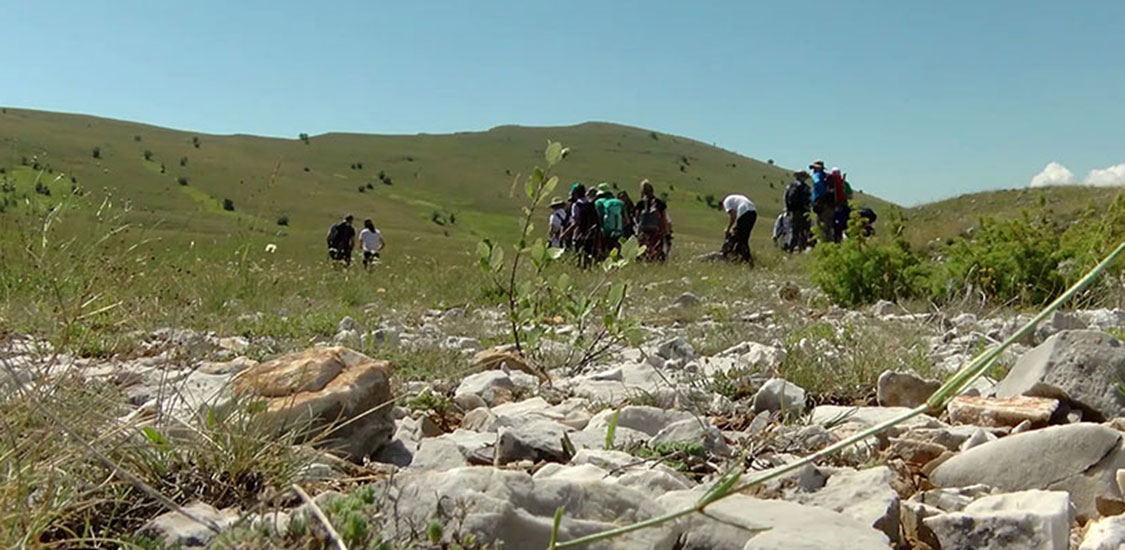
The lynx is not the only species threatened with extinction
Macedonia is rich in flora and fauna, and the biodiversity features a large number of endemic species, which should be considered of immense value for a country. Contrary to that, Macedonia gives very little importance to this natural wealth and no investments are made in research on the state of flora and fauna. The best indicator of this is the slow updating of the National Red List, which should be a guide for preparation of measures and activities for monitoring and saving of animals and plants whose survival is under threat by various factors.
The endangered heritage
Despite the fact that the diversity of flora and fauna has not yet been studied in full, the current knowledge reveals a huge wealth of species in Macedonia. According to the data from the latest environmental statistics published by the State Statistical Office, the country has 23,019 taxa (a category of any rank, which covers all subordinate categories). Of these, 2,095 are species of algae, 2,000 species of fungi, 450 species of lichens, 3,200 species of vascular plants and 500 species of mosses; 13,379 invertebrates and 555 species of vertebrates, of which 950 species are Macedonian endemics.
In terms of international standards, many of the plants are endangered.
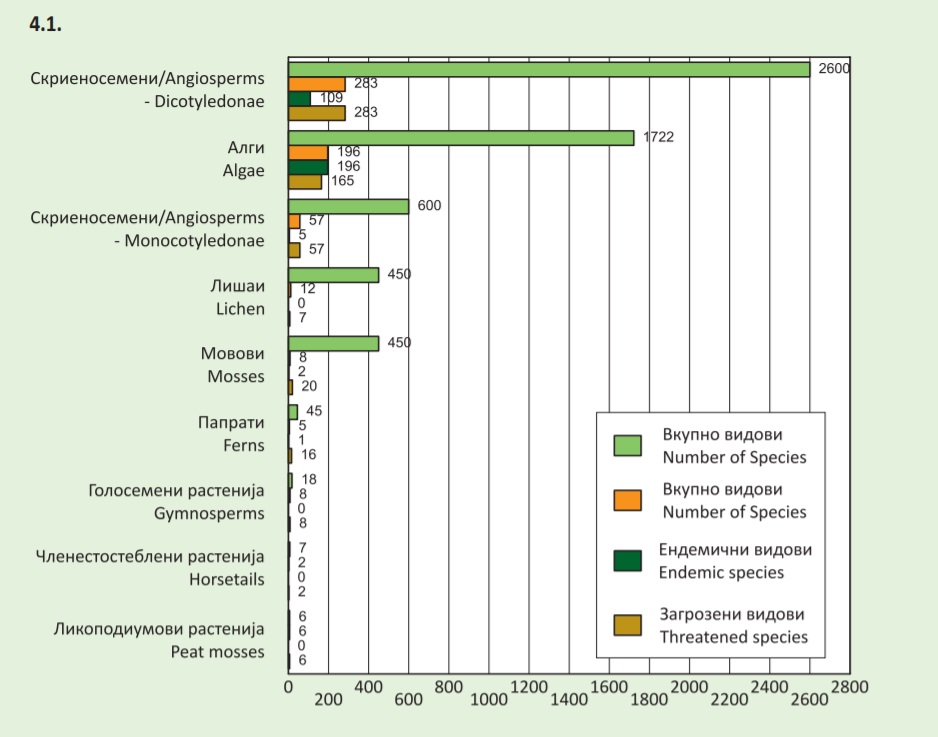
Total number of endemic and endangered species of flora, determined by international documents and national legislation (Source: State Statistical Office)
The situation is similar with the fauna. There is a large number of birds, mammals, fish and amphibians in Macedonia that fall into the ‘endangered’ category. There are 113 vertebrate fauna species living in the country that are included in the European Red List. The highest percentage of endemism among vertebrates is in the class of fish (34.5%). In terms of other classes, 4 endemic taxa are registered in mammals alone. From a total of 27 endemic fish species, 17 are included in the category of globally endangered species.
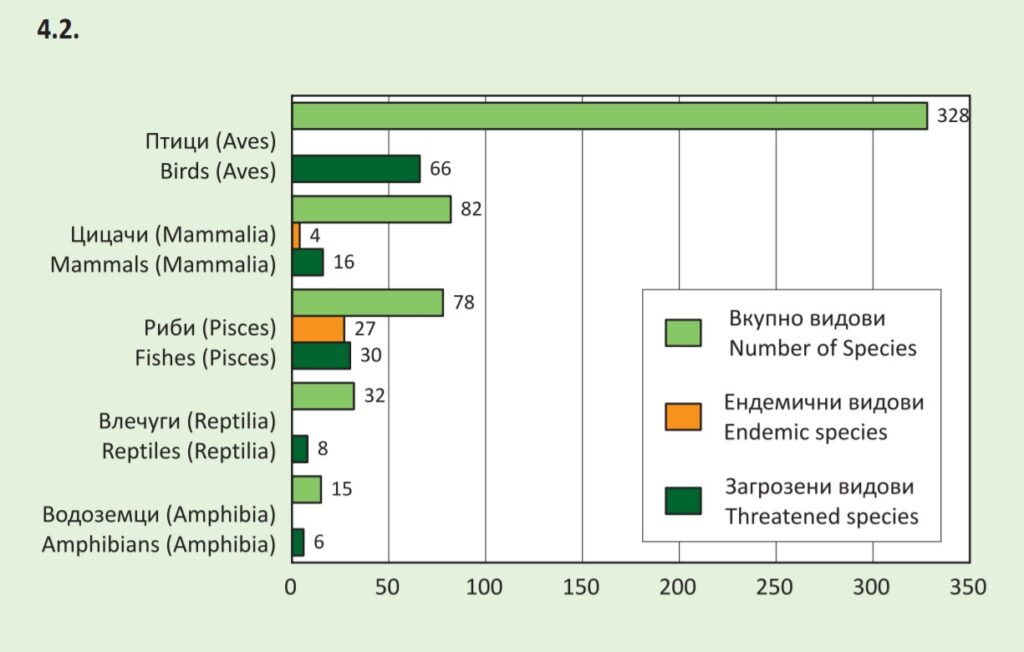
Total number of vertebrate species, endemic and endangered species, determined by international documents and national legislation (Source: State Statistical Office)
Alarm for the red lists
The red lists (national and regional) in Europe and in the world related to plants and animals have been established since long time ago. They include data on the characteristics of the plants and animals and define the precise criteria for their endangerment status. The need for national red lists for larger number of taxonomic groups became clear in Macedonia only in 2017. This need is recognized by the academic community, civil society organizations and the authorities through strategies that include actions and goals for development of national red lists within the National Strategy for Nature Protection with Action Plan (2017-2027) and the National Strategy for Biodiversity with Action plan (2018-2023).
The first concrete steps were made in the middle of 2017 when the process of drafting of these lists started for the first time.
ОThe Ministry of Environment and Physical Planning informs that since then national red lists have been prepared for 14 species of amphibians, 32 species of reptiles and 14 species of plants.
“The results show that we have species that are assessed as vulnerable, endangered and critically endangered”, was the response from the Ministry.
Although modest in terms of number of species, the existing red lists offer a wealth of information. Similar research is lacking for other species in the country.
When asked was there extinction detected of certain plants or animals or species that fall into the category of critically endangered, the Ministry said that this is a process that requires securing of budget funds and intensive field monitoring.
“There are certainly specific threats that need to be constantly monitored. In the Action Plan for the Prespa Lake, the Ministry of Environment and Physical Planning included activity for restoration measures for the critically endangered waterwheel plant (Aldrovanda vesiculosa), where it is necessary to accurately determine the geographic area of the field activities, mapping of the areas where the species is distributed, ex situ protection, transfer of populations to the facility for endemic and endangered species in the Botanical Garden at the Faculty of Natural Sciences and further renewal of the populations in the lake. The implementation of this activity is responsibility of the Municipality of Resen as entity that manages the SP Prespa Lake”, informs the Ministry.
The Ministry further added that the Macedonian Environmental Association implements a three-year projects which is about specific rare plants within the borders of the existing significant plant areas.
„A total of five plants (Campanula debarensis, Aesculus hippocastanum, Centaurea rufidula, Crocus jablanicensis and Astragalus physocalyx) and four significant plant areas (Jablanica, the Crn Drim gorge, Bogdanci and Dojran Lake) will be covered by the monitoring” was the response from the Ministry.
When asked whether the project for national red lists will continue, that is, whether further research is planned for other species of plants and animals as well, the Ministry says that activities are currently being completed for preparation of new red lists for priority species of fungi and mammals in accordance with the International Union for Conservation of Nature (ICUN) methodology.
“Furthermore, MANU is implementing activity where conservation status of specific plants stretching in the National Park ‘Galichica’ is also being determined”, says the Ministry.
When asked whether allocation of budget funds for this research is foreseen or money is sought from donors, the Ministry responded that generally donor money is used for these activities.
If we take into account the number of species of plants and animals in the country that are on the European red lists and the modest research that is currently being done for some of them, it becomes clear that certain species in Macedonia can easily disappear while we wait for donors to become interested in saving them. That is why it is necessary for the government to find mechanisms for regular allocation of funds from the budget on regular basis for researching flora and fauna since these activities are not financially demanding and can significantly contribute to preservation of our natural heritage.
The waterwheel plant available only in aquariums
In the modest National Red List of Macedonia, one of the endangered plant species that has been included is the waterwheel plant (Aldrovanda vesiculosa). It is a free-floating, rootless, carnivorous, submerged aquatic plant. The species grows in lakes, streams and swamps. Prefers clean, shallow, warm constant water with clear light, low nutrient levels and slightly acidic pH.
 The waterwheel plant floats near the surface of the water. The growing season lasts from early or mid-spring to early autumn (Photo credit: Renata Chuchterevska)
The waterwheel plant floats near the surface of the water. The growing season lasts from early or mid-spring to early autumn (Photo credit: Renata Chuchterevska)
The species is spread mainly through the movement of the water birds: the plants catch on a bird’s feet and are transported to the next aquatic destination of that bird.
In Prespa Lake it appears in shallow water sections between the lake and the reeds, mainly along abandoned boat crossings between reeds formerly used by fishermen and always close to the tributaries.
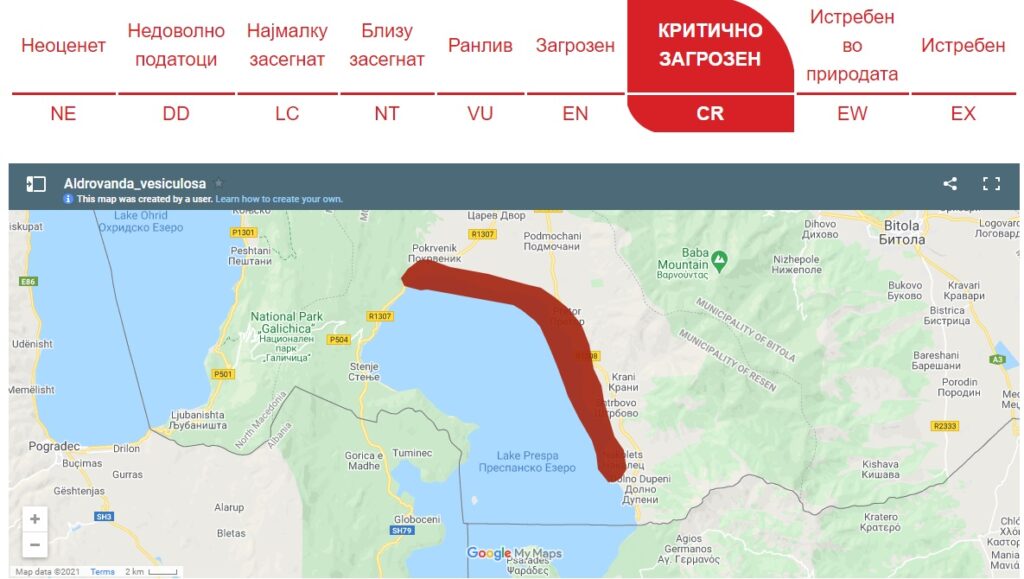
The population of Aldrovanda vesiculosa on the territory of Macedonia has a very limited distribution along the shores of Prespa Lake (between Ezerani and Dolno Perovo).
The National Red List reads: “Data from various scientific papers between 1969 and 2019 indicate a fluctuation of the population of this species. The only reason is the long-term oscillation of the water level. The species was not identified during the field work for assessment for the purpose of the Red List. The reason is the long-term fluctuation of the water in Prespa Lake”.
The continuous decrease of the water level in Prespa Lake over the years and the human impacts (wastewater from agricultural activities and disposal of solid waste in the lake, together with pollution from household waste, water extraction and impacts from fishing) have a negative impact on the population of the waterwheel plant.
“This plant species is intolerant of habitat degradation primarily due to pollution and changes in the aquatic chemistry. Because the environmental requirements of the plant are very strict, it is very sensitive and is one of the first plants to disappear. This extreme sensitivity is normal for a plant on the edge of its distribution” says the Red List.
This content was prepared by the Institute for Communication Studies
Journalist: Vladimir Nikolovski




